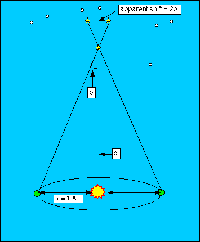variable stars
Special Notice #222: Bright Supernova in UGC 5189A: SN 2010jl
November 5, 2010: We have been informed by Tim Puckett and by the Central Bureau for Astronomical Telegrams (CBET 2532, Daniel W. E. Green, Ed.) of the discovery of a bright possible supernova in UGC 5189A by J. Newton and Puckett, Portal, AZ, on November 3.52 UT at unfiltered magnitude 13.5. Confirming images (limiting magnitude 19.1) by Puckett on Nov. 4.50 UT showed the object at magnitude 12.9./p>
Special Notice #221: Infrequent Outburst of the SU UMa Variable HT Cas
November 2, 2010: As reported by Tim Parson (Circle Pines, Minnesota, USA) and confirmed by Pavol Dubovsky (Kolonica, Slovakia), the infrequently-outbursting dwarf nova HT Cas is in outburst. Parson observed HT Cas in outburst at m(vis)=12.9 on JD 2455502.93 (2010 November 2.43), and the outburst was confirmed by Dubovsky at m(vis)=12.4 on JD 2455503.3 (2010 November 2.8). The last confirmed well-observed outburst of this star occurred on 2008 January 10. Observations of this variable are strongly encouraged at this time. Both visual and CCD observations are en
Variable star posters and talks
AAVSO staff members frequently give talks and present posters on the AAVSO, its activities and its mission. The list of presentations below is a partial compilation of talks and papers given by AAVSO staff over the past several years.
The work of many lives: four centuries of light curves (and counting) (1.9MB PDF), M. Templeton, Stars: Old, Young, and Variable, Iowa State University, May 2014
The Cosmic Distance Ladder
 Distances in the universe are so vast that we do not have a simple way of measuring them. For distances within the solar system we can measure them directly, using radar for example, and some very straightforward trigonometry. But radar is hard to use when it takes light minutes or hours to cross the solar system; and the nearest star is four light years awa
Distances in the universe are so vast that we do not have a simple way of measuring them. For distances within the solar system we can measure them directly, using radar for example, and some very straightforward trigonometry. But radar is hard to use when it takes light minutes or hours to cross the solar system; and the nearest star is four light years awa
Stellar Evolution
Variable stars highlight an important fact about the heavens above us: the universe is always changing. The universe is very large, stars and galaxies are very far away, and many changes occur on timescales far longer than we can see. Most things in the sky -- stars, nebulae, and galaxies -- don't appear to change at all during the course of a human lifetime.
Naming Variables
 The International Astronomical Union (I.A.U.) appoints a committee that determines the names given to variable stars. The assignments are made in the order in which the variable stars were discovered in a constellation. If one of the stars already having a Greek letter name is found to be variable, the star will be referred to by the Greek name.
The International Astronomical Union (I.A.U.) appoints a committee that determines the names given to variable stars. The assignments are made in the order in which the variable stars were discovered in a constellation. If one of the stars already having a Greek letter name is found to be variable, the star will be referred to by the Greek name.
Observing Variable Stars
 Astronomy is a unique science that cannot be studied in a typical laboratory setting here on earth. Instead, astronomers turn their attention and telescopes to the sky in order to study their subjects.
Astronomy is a unique science that cannot be studied in a typical laboratory setting here on earth. Instead, astronomers turn their attention and telescopes to the sky in order to study their subjects.

